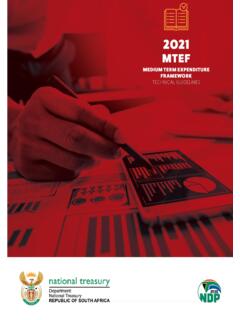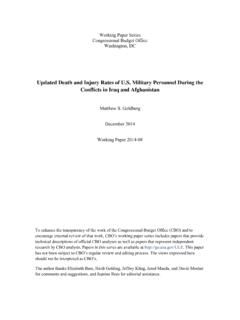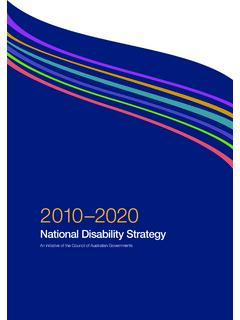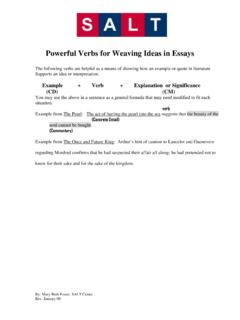Transcription of Political System and State Structure of Pakistan
1 Political System and State Structure of Pakistan POST-INDEPENDENCE AND CONSTITUTION The 1973 Constitution declared Pakistan as a Federal Repub- Within the first few years of its' birth, post-independence Paki- lic to be known as the Islamic Republic of Pakistan , recognizing stan faced a number of challenges. The first of two significant Islam as the religion of the State . Pakistan was to be a Federa- deaths, first in 1948 of its first head of State , Muhammad tion of four federating Units, Punjab, Sindh, the NWFP and Ba- Ali Jinnah, and then the assassination in 1951 of its first lochistan. The Constitution was parliamentary in nature, with a Prime Minister, Liaqat Ali Khan, destabilized the new country, bicameral legislature at the Center consisting of two Houses, and may have been the cause of the emergence of conflict- the National Assembly and the Senate.
2 Although the 1973. ing visions of the ideological direction the country ought to Constitution has been held in abeyance during military rule in pursue. It took almost eight years (till 1956) to agree to a the late 1970s/early 1980s, and has to date, been amended final constitution, establishing Pakistan as a republic within the 19 times, it is currently the constitution governing the State . Commonwealth. Within two years, the new parliamentary sys- The 18th Amendment to the Constitution, which was passed tem was facing challenges, and in 1958, General Ayub Khan in April 2010, removed most of the constitutional changes launched Pakistan 's first military coup, declaring martial law. introduced during military regimes, as well as formally chang- In 1960 Khan became President, and by 1962, Pakistan saw ing the name of the North West Frontier Province to Khyber its' second constitution, with politics placed in the firm grip Pakhtunkhwa, and has granted provinces greater autonomy.
3 Of the military. At this point, the turmoil caused by the failure to win a second war with India in 1965, mounting corruption Executive and increasingly taxing relations with East Pakistan gradually The 1973 Constitution lay down that the President was to be undermined Khan's authority, finally forcing his resignation in the Head of the State . The President was to act on the advice 1969. The first election on a nationally democratic basis was of the Prime Minister of Pakistan , and could be removed on conducted in 1970. The elections saw the primarily East-Pa- the grounds of physical or mental incapacity or impeached on kistan based Awami League, lead by Shaikh Mujibur Rahman, charges of violating the Constitution or gross misconduct by a gaining an overall majority. However, the results were not two-thirds vote of the members of the parliament. well-received in West Pakistan , and power was not transferred to elected leaders.
4 This set the stage for a new constitutional The President crisis where, in the period following, relations between East The President of Pakistan is chosen by a secret ballot through and West Pakistan further polarised. In March 1971 Mujibur an Electoral College comprising the Members of the Senate, Rahman declared an independent People's Republic of Bang- National Assembly and the Provincial Assemblies. A person who ladesh, setting the stage for a nine month long civil war. In is a Muslim and not less than 45 years of age and is qualified to December 1971, India interceded in support of East Pakistan , be elected as a Member of the National Assembly can contest and the ensuing Indo-Pak war resulted in a humiliating sur- the Presidential election. The President is elected for a term of render by Pakistani forces. The surrender also marked the 5 years and is authorized to appoint the Attorney General, Judg- emergence of the former East Pakistan as an independent es of Supreme Court and High Courts, and the Chief Election country, Bangladesh.
5 Commissioners. In the Provincial Government, each province General Yahya Khan resigned the presidency in the aftermath was to have a Governor appointed by the President. He could be of the war, and handed over leadership to Zulfiqar Ali Bhutto, re-elected but could not hold office for more than two terms. Ayub Khan's former Foreign Minister, and the founder and leader of the Pakistan People's Party, which had won the ma- The Prime Minister jority of seats from West Pakistan in the elections of 1970. The Prime Minister is appointed by the President from among Bhutto became President and also the first civilian Chief Mar- the members of the National Assembly, and has to demon- tial Law Administrator. The National Assembly approved the strate majority support in the House. The Prime Minister is 1973 Constitution on April 10, 1973, and it came into effect assisted by the Federal Cabinet, a council of ministers whose on August 14.
6 Bhutto took over as the Prime Minister of Paki- members are appointed by the President on the advice of the stan from this date and FazalIlahi Chaudhry was appointed as Prime Minister. The Federal Cabinet comprises the ministers, the President of Pakistan . ministers of State , and advisers 1. Pakistan : Country Profile 1947-1948 1948-1951 1951-1955 1956-1958 1958-1969 1969-1971 1971-1973. Mohammad Ali Khawaja Malik Ghulam Iskaner Mirza** Ayub Khan Yahya Khan Zulfikar Ali Jinnah* Nazimuddin* Muhammad* Bhutto Pakistan . MUSLIM LEAGUE MUSLIM LEAGUE REPUBLICAN PARTY MILITARY MILITARY PEOPLES. PARTY. * From 1947 to 1956, there was no office of the President. The head of State was the Governor General. **In 1956, Iskander Mirza, who was then the Governor General, automatically assumed office as the President, since the post of Governor General was abolished.
7 Table 1. Allocation of Seats in the National Assembly Legislature Khyber Pakhtunkhwa*. The bicameral federal legislature is the Majlis-i-Shoora (Council of Advisers), consisting of the Senate (upper house) and Na- Federal Capital tional Assembly (lower house). Balochistan The National Assembly Punjab TOTAL. Sindh FATA. Members of the National Assembly are elected by universal adult suffrage (over eighteen years of age in Pakistan ). The National Assembly has 342 seats, 272 of which are elected General 148 61 35 14 12 2 272. on a first-past-the-post The candidate who gains the Women 35 13 8 4 0 0 60. major number of votes in a single constituency is nominated Non-Muslims - - - - - - 10. elected member of the National or Provincial Assembly. Of TOTAL 183 74 43 18 12 2 342. the 70 remainder seats, 60 are reserved for women and ten * Former NWFP. for non-Muslim minorities; they are allocated, on the basis of Source: National Assembly Secretariat proportional representation, to parties that win more than 5%.
8 Of the directly elected seats. Seats are allocated to each of the four provinces, the Federally Administered Tribal Areas, and Both the Senate and the National Assembly can initiate and Islamabad Capital Territory on the basis of population. National pass legislation except for money bills, where the National As- Assembly members serve for the parliamentary term, which sembly has an edge over the Senate, legislating exclusively on is five years, unless they die or resign sooner, or unless the money matters. Only the National Assembly can approve the National Assembly is dissolved. Graph 1 shows the current federal budget and all money bills. With exception to money distribution of seats in the National Assembly. matters, however, both the Houses work together to legislate. The Bills relating to the Federal Legislative List can originate The Senate in either House.
9 If one House passes the Bill through majority The Senate is a permanent legislative body with equal rep- vote, it is transmitted to the other House. If the other House resentation from each of the four provinces, elected by the passes it without amendment, it is presented to the President CIDOB International Yearbook 2012. members of their respective provincial assemblies. The chair- for assent. If the Bill, transmitted to the other House, is not man of the Senate, under the constitution, is next in line to act passed within ninety days or is rejected, it is considered in a as President should the office become vacant and until such joint sitting of parliament, to be summoned by the President time as a new President can be formally elected. The Federally on the request of the House in which the Bill originated. If the Administered Tribal Areas (FATA) and Islamabad Capital Terri- Bill is passed in the joint sitting, with or without amendments, tory also have representatives presenting the Senate,2 which by the votes of majority of the members of the two Houses, it has a total of 100 members, of whom 14 members are elect- is presented to the President for assent.
10 The President is re- ed by each Provincial Assembly, 8 members are elected from quired to assent to bills passed by both houses within ten days. Federally Administered Tribal Areas (FATAs) by the Members However, in all bills except the Finance Bill, the President may of National Assembly from these areas, 2 members, 1 woman return the Bill to the parliament with a message requesting and 1 Technocrat is elected from the Federal Capital by the that the Bill be reconsidered and that an amendment specified Members of National Assembly, 4 women and 4 Technocrats in the message be considered. The parliament is supposed to are elected by the members of each Provincial Assembly. The reconsider the Bill in a joint sitting. If the Bill is passed again, term of the members of the Senate is 6 years. However, the with or without amendment, by vote of the majority of the term of the first group of the Senators, who shall retire after members present and voting, it is presented to the President completion of first 3 years of the Senate, is determined by and the President is required to give his assent within ten days.





